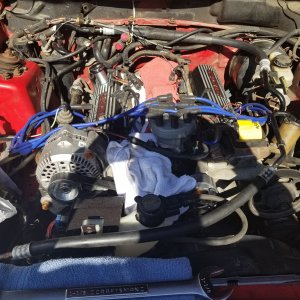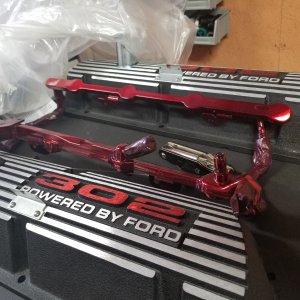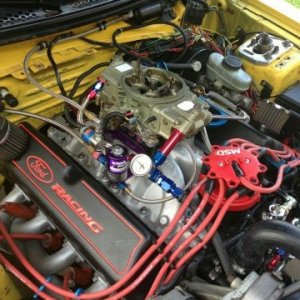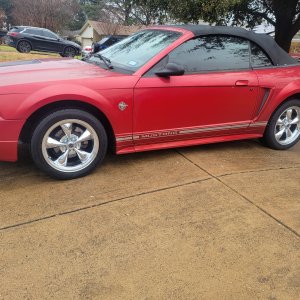Alot of people have gotten on the bandwagon by thinking you need PI heads with the PI cams and PI intake. You don't and there are some running 12.3's on NA NPI headed motors.
For the owners of the 1996 – 1998 Ford 4.6L 2V Mustang GT, the PI (Power Improvement) swap can provide an excellent power boost for these underpowered motors. The PI swap may consist of a complete head and intake swap for full power benefits or just a PI cam and intake swap for decent power gains and other considerations. The pros and cons of both are discussed below.
Note: 1996 – 1998 Mustang GT’s are non power improved (nPI) equipped cars. 1999 – 2004 Mustang GT’s are power improvement (PI) equipped cars.
The PI cam and intake swap also provides decent power gains absent the draw backs associated with the PI head and intake swap. Swapping PI cams and a PI intake on nPI Stangs results in a 30 – 35 RWHP gain. The cams alone result in a 13 – 16 RWHP gain and the intake results in a 15 -18 RWHP gain. The extra 10-15 on the PI head is the bump in compression with an added cost for the heads.
The benefits of this swap are lower costs, less labor, and the fact that you maintain stock compression ratios. PI cams can be purchased used from many parts forums (such as those found on Corral, Modular Depot, or Mustang World) for about $100. PI intakes can be purchased for $100 - $200 depending on condition and whether or not they have the aluminum cross-over (recommended). The install kit with all the gaskets, heater tube etc, is about another $50 - $60. Therefore, for about $300 or less you can obtain up to an extra 35 RWHP making this mod an excellent dollar for horsepower gain! In addition you can use the saved money to port the NPI heads that will have more hp than if you went the PI head route. Some of the common rebuttles is "well i will prot the PI heads then". However, the drawback is that you have introduced much more airflow that the Pi cams, which are oem btw, can't be used to their full potential resulting in no real gain, but possibly a loss of hp. Too much airflow for the cam setup isn't going to yield hp.
When swapping PI cams, I recommend that you purchase 2001 + cams. These cams are Romeo cams (manufactured in the Romeo plant) and they have bolt on sprockets. Since the sprockets can be unbolted, you can use the Anderson tool to swap the cams. This makes the job a snap since all you have to do is take off the valve covers, cam covers, use the tool to hold the timing chain in place and then swap cams. Conversely, to do the entire PI head swap, you will have to either pull the entire motor, or tear it down in place to remove the heads.
The PI intake is a considerable improvement over the nPI intake. With its increased port volume and improved runner design, this intake has been shown to give up to 18 RWHP increases to the nPI equipped Stang.
When swapping the PI intake on nPI heads, make sure you purchase nPI gaskets since these gaskets seal the water ports. Failure to seal the water ports can result in coolant leaking into the combustion chamber and subsequent engine failure, so be sure to use nPI gaskets. Although these gaskets effectively seal the water ports (a must), they do not completely seal the intake ports. You must use high temp silicone sealant (permatex) to seal these ports. AGAIN… only apply the permatex to the intake. Applying excessive amounts of sealant can cause it to ooze into the intake port and obstruct it resulting in hesitation and reduced power.
I hope this helps any future 96-98 GT owners that you do not need a PI head to make power with these cars. Johnny Langton pioneered the first PI cam and intake swap and his 4.6 2v NPI motor runs 12.3 so he is proof this can be done and on a budget.
For the owners of the 1996 – 1998 Ford 4.6L 2V Mustang GT, the PI (Power Improvement) swap can provide an excellent power boost for these underpowered motors. The PI swap may consist of a complete head and intake swap for full power benefits or just a PI cam and intake swap for decent power gains and other considerations. The pros and cons of both are discussed below.
Note: 1996 – 1998 Mustang GT’s are non power improved (nPI) equipped cars. 1999 – 2004 Mustang GT’s are power improvement (PI) equipped cars.
The PI cam and intake swap also provides decent power gains absent the draw backs associated with the PI head and intake swap. Swapping PI cams and a PI intake on nPI Stangs results in a 30 – 35 RWHP gain. The cams alone result in a 13 – 16 RWHP gain and the intake results in a 15 -18 RWHP gain. The extra 10-15 on the PI head is the bump in compression with an added cost for the heads.
The benefits of this swap are lower costs, less labor, and the fact that you maintain stock compression ratios. PI cams can be purchased used from many parts forums (such as those found on Corral, Modular Depot, or Mustang World) for about $100. PI intakes can be purchased for $100 - $200 depending on condition and whether or not they have the aluminum cross-over (recommended). The install kit with all the gaskets, heater tube etc, is about another $50 - $60. Therefore, for about $300 or less you can obtain up to an extra 35 RWHP making this mod an excellent dollar for horsepower gain! In addition you can use the saved money to port the NPI heads that will have more hp than if you went the PI head route. Some of the common rebuttles is "well i will prot the PI heads then". However, the drawback is that you have introduced much more airflow that the Pi cams, which are oem btw, can't be used to their full potential resulting in no real gain, but possibly a loss of hp. Too much airflow for the cam setup isn't going to yield hp.
When swapping PI cams, I recommend that you purchase 2001 + cams. These cams are Romeo cams (manufactured in the Romeo plant) and they have bolt on sprockets. Since the sprockets can be unbolted, you can use the Anderson tool to swap the cams. This makes the job a snap since all you have to do is take off the valve covers, cam covers, use the tool to hold the timing chain in place and then swap cams. Conversely, to do the entire PI head swap, you will have to either pull the entire motor, or tear it down in place to remove the heads.
The PI intake is a considerable improvement over the nPI intake. With its increased port volume and improved runner design, this intake has been shown to give up to 18 RWHP increases to the nPI equipped Stang.
When swapping the PI intake on nPI heads, make sure you purchase nPI gaskets since these gaskets seal the water ports. Failure to seal the water ports can result in coolant leaking into the combustion chamber and subsequent engine failure, so be sure to use nPI gaskets. Although these gaskets effectively seal the water ports (a must), they do not completely seal the intake ports. You must use high temp silicone sealant (permatex) to seal these ports. AGAIN… only apply the permatex to the intake. Applying excessive amounts of sealant can cause it to ooze into the intake port and obstruct it resulting in hesitation and reduced power.
I hope this helps any future 96-98 GT owners that you do not need a PI head to make power with these cars. Johnny Langton pioneered the first PI cam and intake swap and his 4.6 2v NPI motor runs 12.3 so he is proof this can be done and on a budget.










